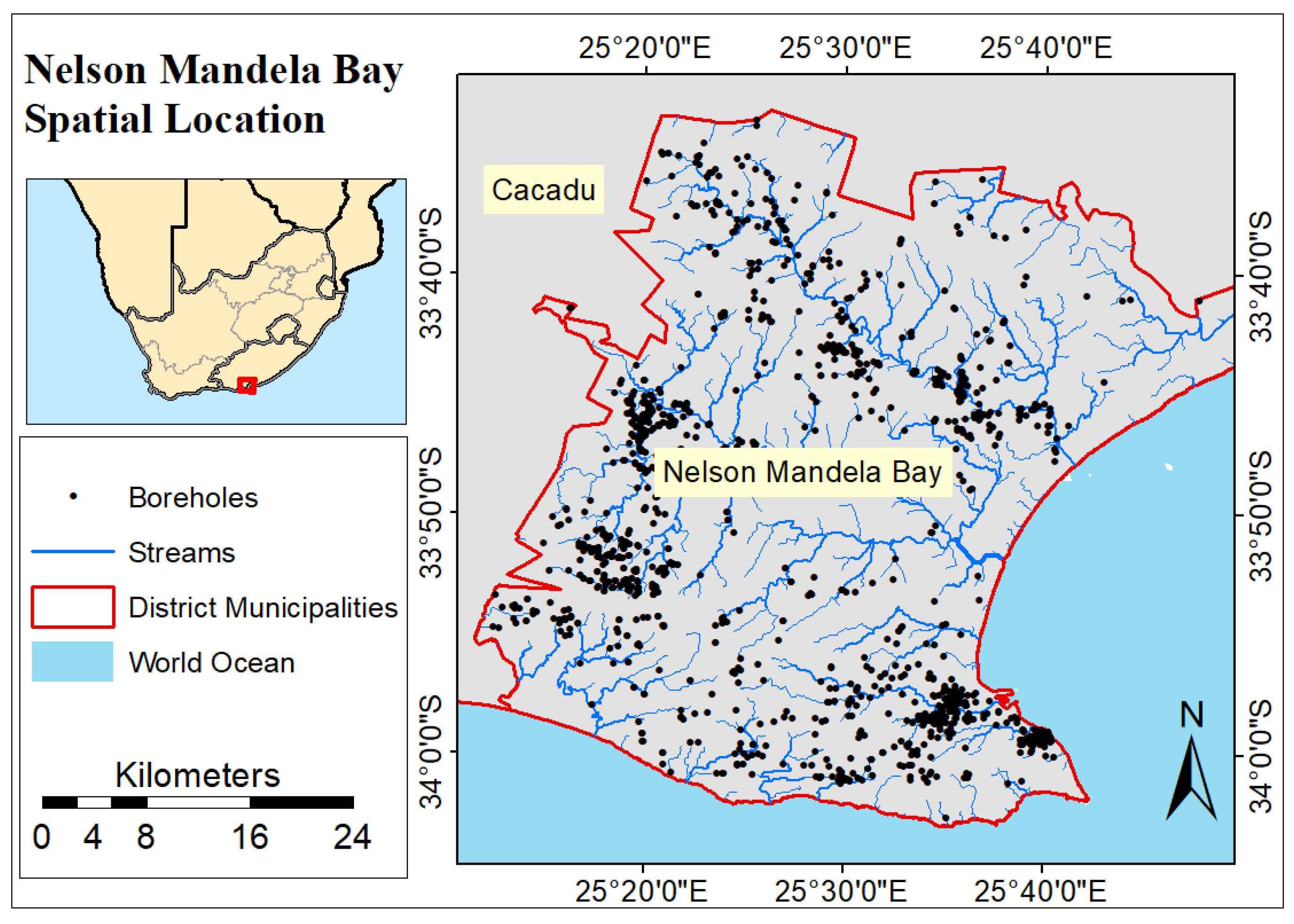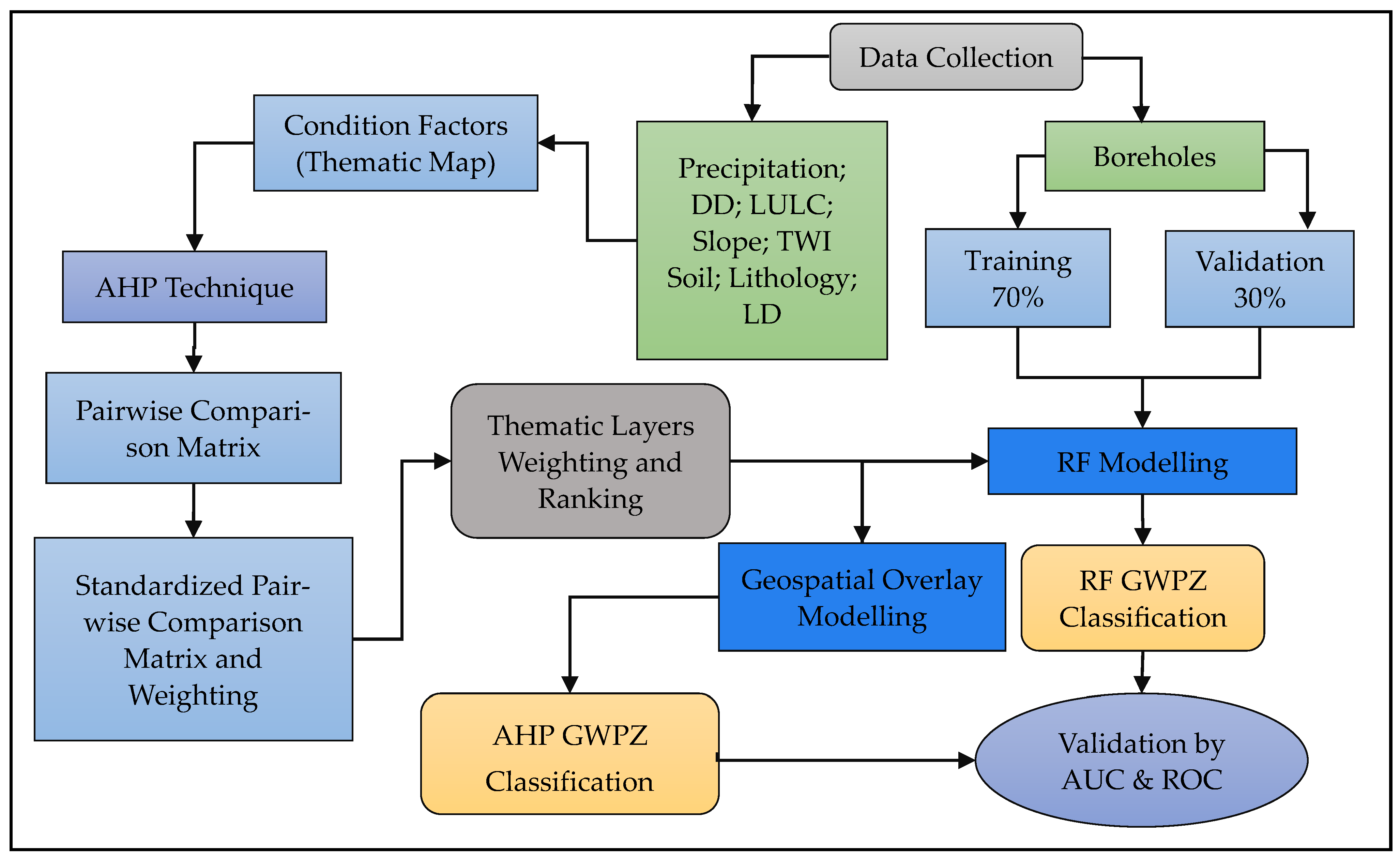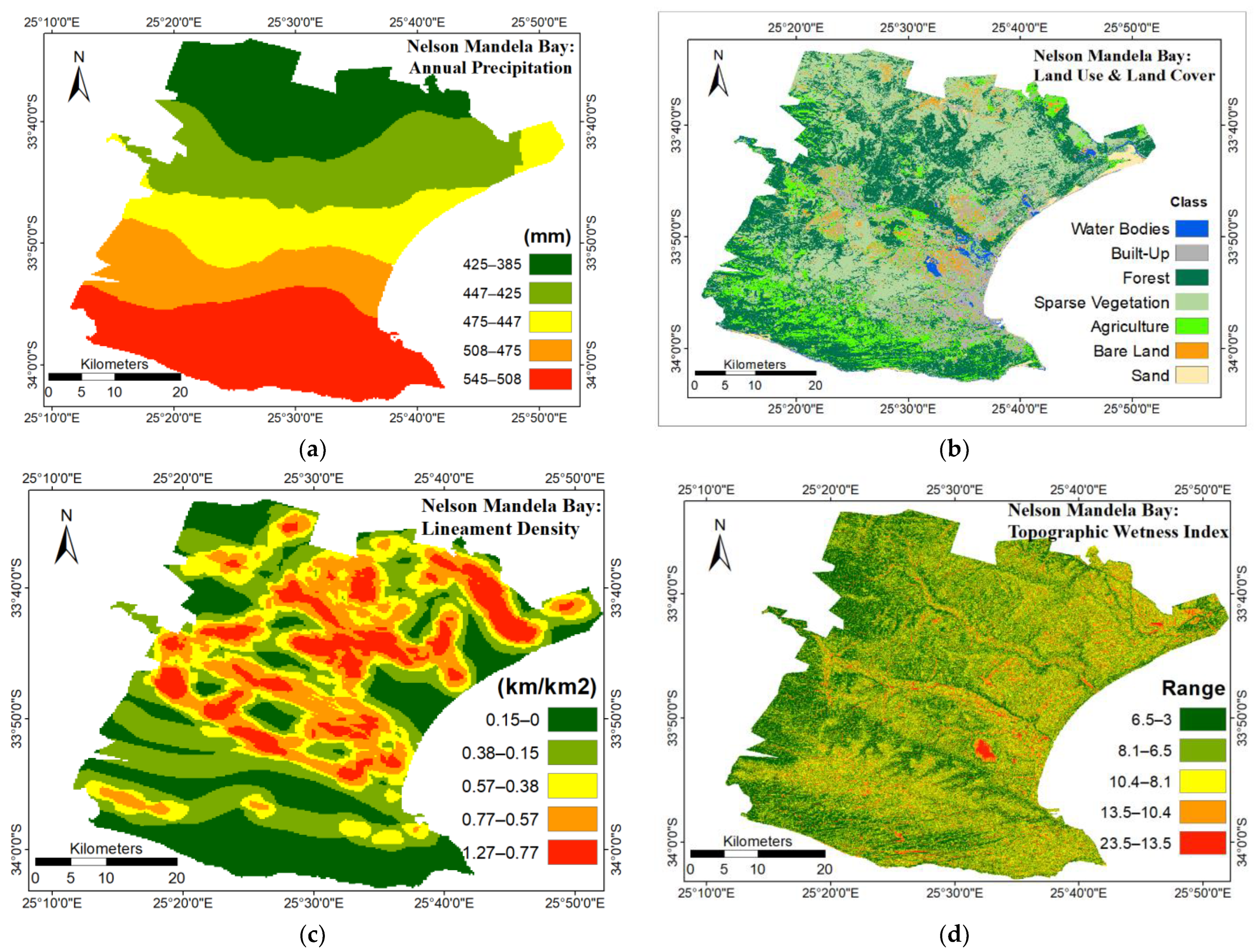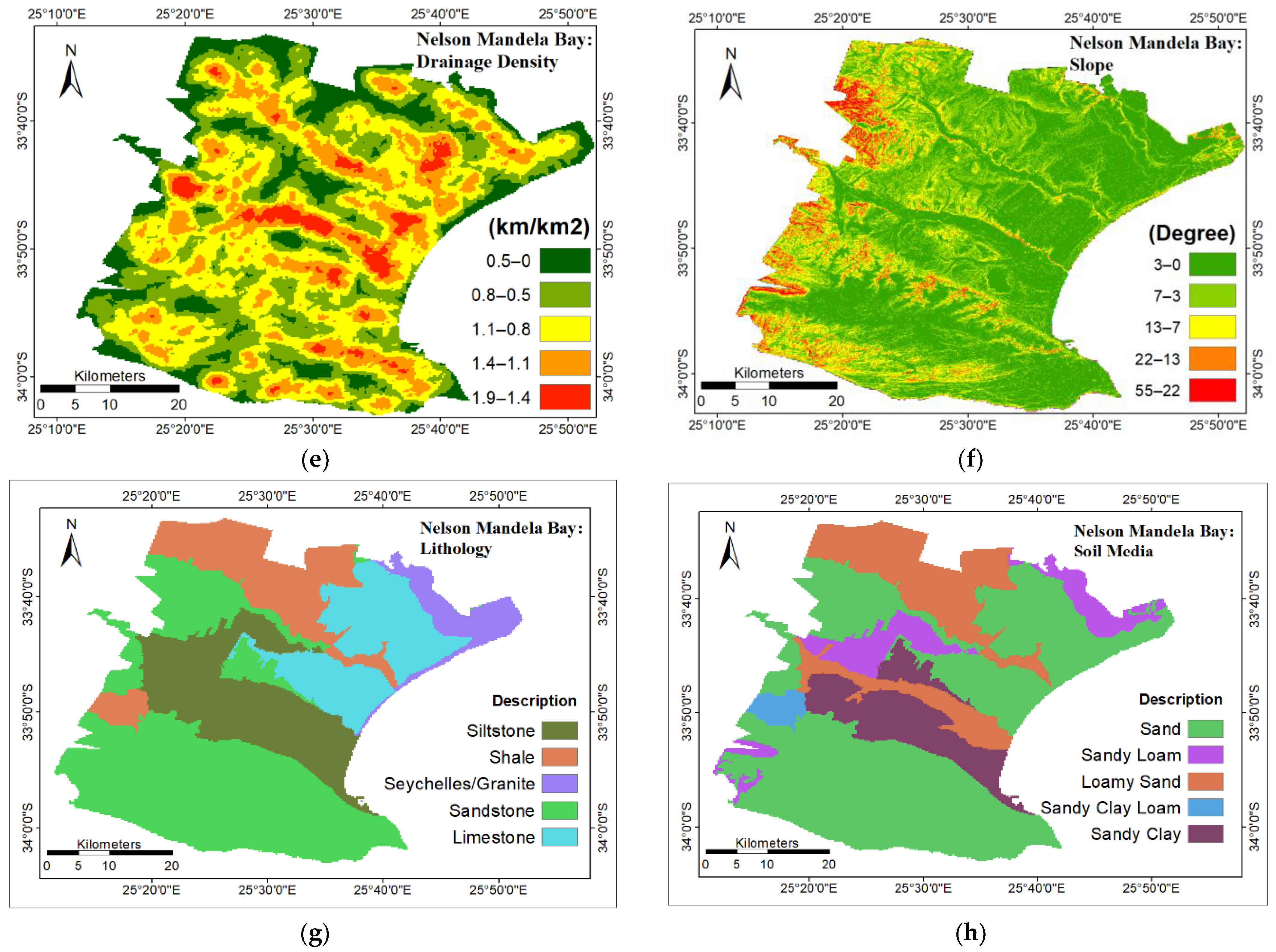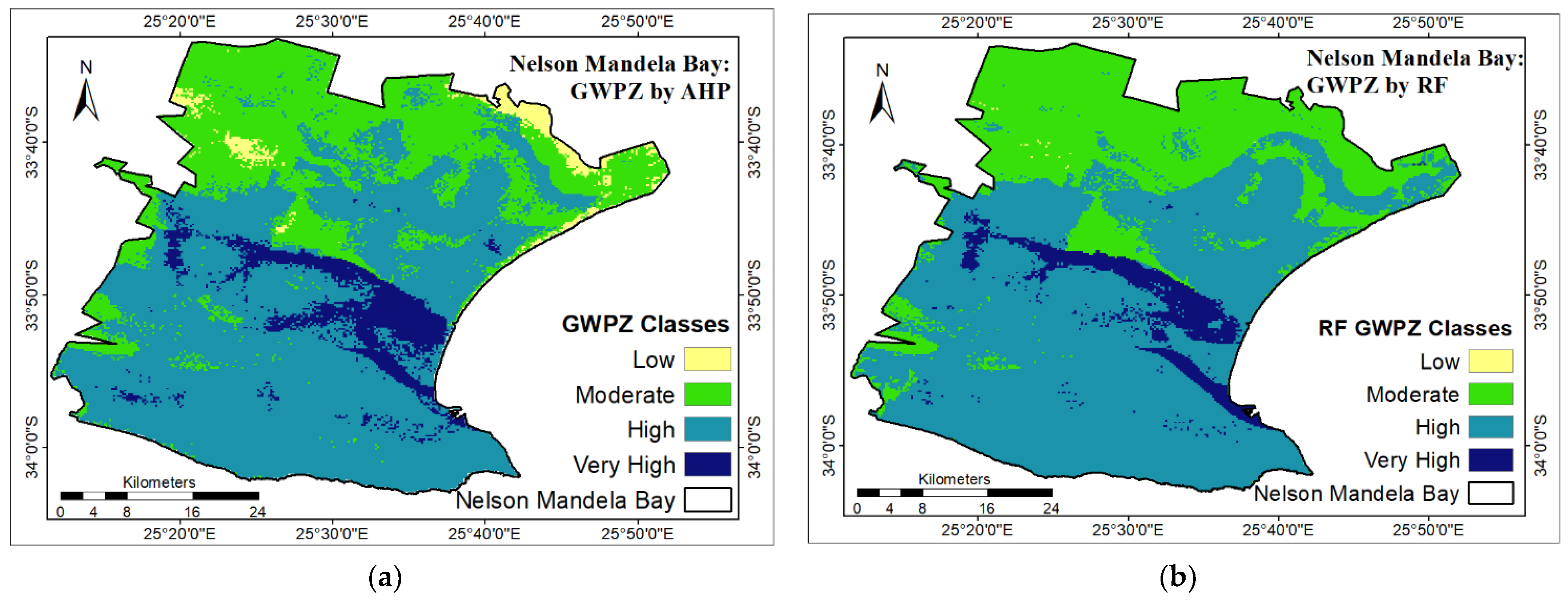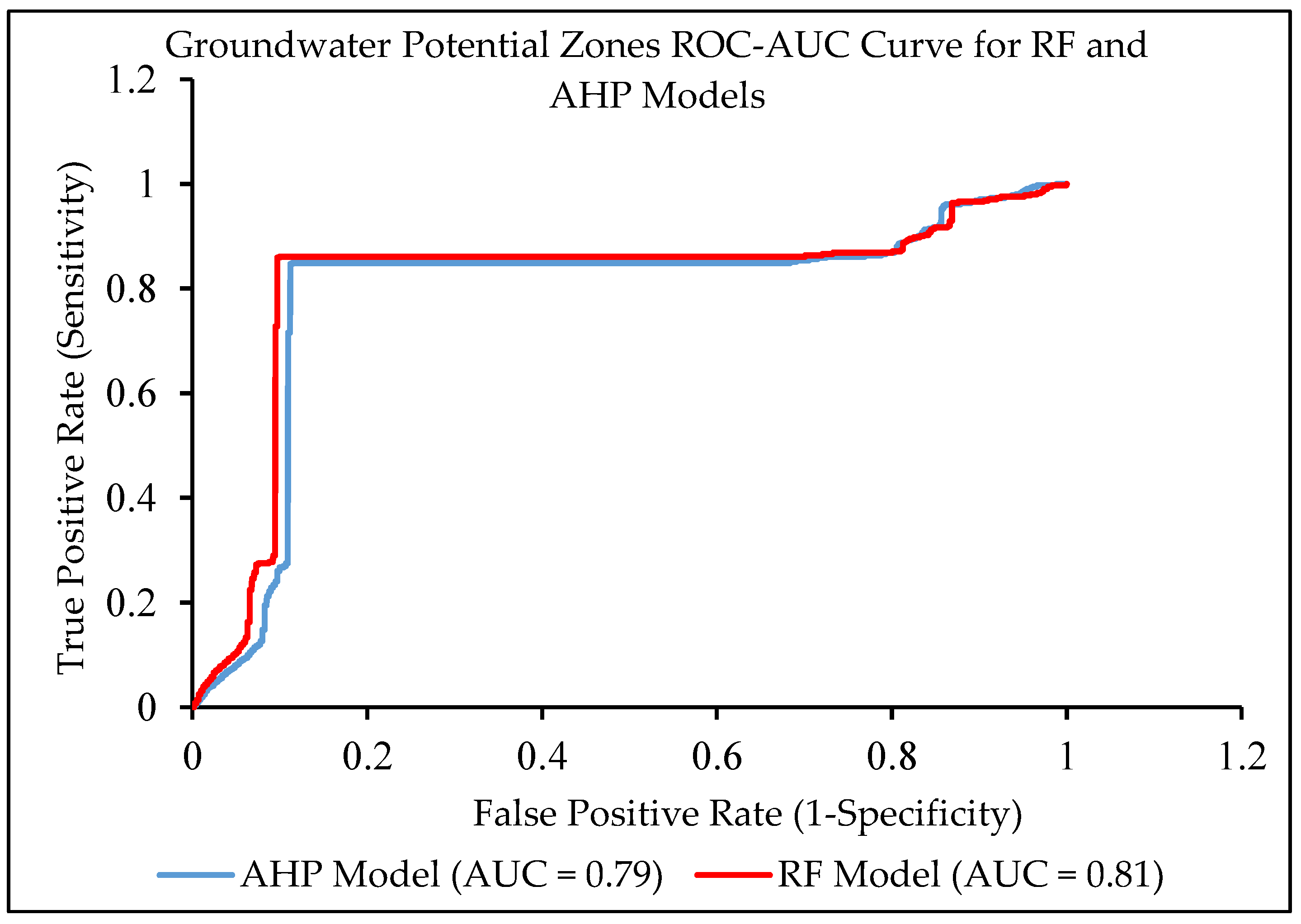1. Introduction
Water scarcity has been identified as a major issue, especially in developing nations where there are insufficient exploration methods and inadequate water supply to meet the population demand [
1]. South Africa has recorded inadequate water distribution with a sharp increase in water shortage [
2], where provinces such as Eastern Cape have declared a surge in water demand since municipalities were confronted with the challenge of meeting water users’ demands. Since surface water faces many challenges, including availability, scientists have revealed that groundwater could play a significant role in meeting water users’ demands.
Groundwater, which is usually defined as the water that exists in the pore spaces of rock or soil [
3], represents about 30% of the globe’s freshwater [
4] and has a vital function in the hydrological cycle [
5], especially in areas with limited access to freshwater, where it serves as vital freshwater for both urban and rural communities. Groundwater normally exists in the saturated zone where pore spaces are mostly filled with water. The unsaturated zone (vadose zone) is where pore spaces are filled with both air water [
6], where not all pore spaces are filled with water. Groundwater is less subject to climate change and has been shown to be an affordable choice for agriculture, industrial, domestic, and other uses [
7]. However, groundwater is little utilized in most African countries due to its operational costs, limited access to technology, lack of infrastructure, and lack of knowledge in terms of its occurrence [
8]. Africa possesses a substantial groundwater storage capacity, which is roughly calculated to be 100 times more extensive than available renewable freshwater and about 20 times larger than the water held in the surface dams or lakes [
9]. The potential of groundwater storage in Africa presents an opportunity to address the continent’s water scarcity issues and underscores the importance of effective management and sustainable use of this valuable resource [
8].
The management and utilization of groundwater require a proper method that measures its quality, quantity and spatial variability, and these measures ensure groundwater sustainability [
10]. Extensive extraction of groundwater can lead to a decrease in the groundwater level [
11], and consequently, effective groundwater monitoring is essential in areas where groundwater plays a central role in the local water supply: “Groundwater mapping serves as an indicator of the variability of groundwater throughout the region and the likelihood of their presence” [
6]. History has revealed that researchers have concentrated on in situ measurements of groundwater potential mapping (GWPM), which are frequently too expensive, time-consuming and impractical for large regional-scale research [
12]. These approaches to groundwater exploration include drilling, geophysics and hydrogeological methods [
10,
13]. Although these methods were often too expensive and time-consuming, they gave accurate and reliable results. As a result, Fajana [
14] attempted to delineate groundwater aquifer potential in Odo Ayedun in Nigeria based on electric resistivity and porosity calculations, where they carried out a reconnaissance survey of the study area to acquire coordinates and interpret vertical electric sounding data for subsurface geology. The traditional methods have helped researchers in achieving aims that pertain to groundwater delineation and have revealed a vital function in recognizing prospective areas for borehole excavation: “The lack of adequate technology in identifying the groundwater potential zones and proper planning remains to be a bottleneck in developing continents” [
6], especially in Africa [
8].
As technology advances, researchers have proved geographical information systems (GISs) and remote sensing (RS) to be more affordable and effective methods in GWPM for sustainable planning, administration, and management of aquifers [
11], since these methods provide an ability to generate complex hydrological content for the spatiotemporal domain [
15] with crucial spatial analysis and predictive modelling equipment. Remote sensing satellites often do not provide the details of groundwater variability by penetrating deeply through the subsurface soil and geological media. Rather, they assist in explaining features that could be associated with the availability of groundwater [
16]. The GIS approach has been integrated with various techniques, such as multicriteria decision-making methods including analytical hierarchical process (AHP) which is widely used for groundwater mapping [
2,
5,
8,
17], and fuzzy-AHP [
18,
19], multi-influencing factor (MIF), fuzzy logic (FL), certainty factor (CF) [
20], weight of evidence (WOE) [
21], evidence belief function (EBF) [
22] for landslide mapping, and index models (IMs) [
17,
23]. Other researchers, such as Mogaji et al. [
24], have also attempted to delineate GWPZs based on techniques such as the Dempster–Shafer theory of evidence (DS-EBF) model, which revealed great accuracy.
The AHP technique, as explained by Abrar et al. [
8], enables researchers to define groundwater potential zones (GWPZs) by evaluating the importance of hierarchically non-saturated criteria concerning those positioned at a high level. Based on the AHP and GIS approach, Ndhlovu et al. [
17] evaluated GWPZs in the Zambezi by assessing the effect of various factors, such as lineament density, lithology, land use and land cover (LULC), soil properties, slope degrees, rainfall, and drainage density, and argued that these factors have the potential in determining groundwater potential. Owolabi [
25] attempted to develop feasible research to demonstrate a GWPZ with a high accuracy in the Eastern Cape, and claimed that the AHP model is vital to delineating GWPZs in semiarid regions. Gintamo [
15] applied GIS-based integrated Saaty’s AHP to derive GWPZs in Ethiopia’s Bilate River Catchment by assessing the extent of impact and contribution of each factor to groundwater potential. Moodley et al. [
5] attempted to delineate GWPZs in KwaZulu Natal (KZN), South Africa based on the AHP approach, claimed their study was the first to establish GWPZs in KZN through an integration of GIS, remote sensing and AHP techniques, and contended that the procedure of delineating GWPZs in South Africa is largely characterized by obsolete, time-intensive, and expensive in situ methods [
6].
Technological progress has shifted towards machine learning (ML) and deep learning (DL), and recent studies have employed these algorithms to accurately derive GWPZs [
10,
26,
27] and improve model accuracy and efficiency [
28]. The ML and DL techniques rely heavily on the availability and quality of the dataset [
29] since these techniques learn from experience and identify hidden patterns [
30]. Researchers have demonstrated the efficiency of ML and DL algorithms in various applications including landslide susceptibility mapping, floods, and groundwater prediction [
6]. There are various types of ML algorithms developed by researchers thus far, including support vector machine (SVM), random forest (RF), boosted regression tree (BRT), classification regression tree (CRT), naïve Bayes (NB), and DL algorithms, including convolutional neural network (CNN), artificial neural network (ANN), recurrent neural network (RNN) and long short-term memory (LSTM) [
6,
10,
11,
31]. For groundwater mapping, researchers have proved the efficiency of the ML and DL algorithms BRT, RF and SVM [
11], RF [
27,
32], CNN and SVM [
33], logistic regression [
34], classification and regression tree (CART) [
35], naïve Bayes [
27], and LSTM [
10] for groundwater prediction. These techniques have allowed researchers to improve their performance through the process of hybrid or model ensembles. Arabameri et al. [
7] employed a new hybrid model that combined random subspace and multilayer perception (MLP) and achieved very high accuracy. Studies such as Hasanuzzaman et al. [
27] have demonstrated the capability of ML by comparing RF with multicriteria AHP, where RF derived GWPZs with high accuracy. Moreover, these techniques still require in situ measurement as an appropriate method of model accuracy validation.
Despite these promising techniques for assessing groundwater resources, the spatial variation of aquifers is recognized at the national level in South Africa, but less is known about the specific case of Nelson Mandela Bay (NMB). Hence, the main objective of this study was to delineate a groundwater potential zone map for Nelson Mandela Bay, South Africa by integrating geographical information system, analytic hierarchical process, and machine learning-based random forest models. The AHP technique was employed to identify optimal parameters and assign weightage to criteria for groundwater potential zone (GWPZ) assessment. The area under the receiver-operating characteristic curve (AU-ROC) was utilized to assess the performance of both the AHP and RF groundwater prediction algorithms. The study also mapped the spatial distribution of groundwater in the NMB region. The groundwater potential zone map derived from this study is anticipated to play a significant role in informing policymakers, water managers, and other stakeholders involved in managing and preserving the region’s groundwater resources, contributing to the long-term resilience and sustainability of South Africa’s water systems.
The introduction of this study provides an overview of the study area and sets forth the study objectives. We explore materials and methods to detail the approach to delineate groundwater potential mapping starting with the preparation of thematic factors. We then apply the AHP technique to compute the weight and ranking of these factors, followed by the construction of a weighted overlay model to generate an initial groundwater map. The RF model enhances the accuracy and robustness of groundwater prediction.
Section 3 showcases the spatial variability of thematic factors and the delineated groundwater potential zones. The model validation and comparison derive which model was most efficient. Finally, the discussion highlights the interpretation of the findings and their implications, while the conclusion summarizes the key outcomes and suggests future research directions.
Overview of the Study Area
Nelson Mandela Bay (NMB) Metropolitan is a vibrant coastal city situated in the Eastern Cape province of South Africa, covering an approximate area of
with its central coordinates marked as 33°48′ S, 25°30′ E, as presented in
Figure 1. NMB is situated on the shores of the Indian Ocean and has a diverse culture and heritage, making it a popular tourist destination, and it is considered an economic giant in the country. NMB lies within a transitional climatic region, characterized by a blend of climatic influence from the KZN summer rainfall and the Western Cape Mediterranean climate [
6,
36]. The positioning of NMB between these climatic regions results in distinct weather patterns and conditions. It features a warm-temperature climate, characterized by an average annual temperature of approximately 22 °C and an average annual rainfall of
. “The southern half of the district is dominated by fractured rocks, which consist of the Table Mountain group” [
6] (shale), Bokkeveld Group (shale and limestone), and a weak rock of the Uitenhage Group (sandstone) [
37].
The district’s lithology consists of shale, sandstone, siltstone, limestone, and granite. The eastern coastline of the district is characterized by a cape fold belt comprising fine-grained quartzites derived from Table Mountain’s sandstone [
36]. The soil composition in NMB predominantly consists of Nanaga coastal formation, sandy loam soil, sandy clay, loamy sand and sandy clay loam. Additionally, the upper Swartkops regions hold agricultural significance due to their favorable soil characteristics [
6,
36]. NMB encompasses extensive forested areas, sparsely vegetated regions, and agriculturally active zones, with 25% of the total area occupied by surface water bodies. The topography of the district is shaped by marine strata filling a wide valley at the terminus of the east–west-oriented Cape Fold Belt. The predominant topographical features consist of flat and gradually sloping areas towards the sea. This configuration is likely influenced by a blend of marine and continental erosion processes [
36]. The mountains protrude in the western boundary of the district.
4. Discussion
The results of this study reveal that NMB has predominantly moderate to high groundwater potential zones, which is why most of the boreholes exist in these zones of the district, as shown in
Table 7. Such congruence in performance with previous studies is indicative of the robustness and reliability of the AHP and RF models in accurately delineating groundwater potential [
10,
38]. The result suggests a high potential of groundwater in NMB and aligns with previous studies that have argued the high potential of groundwater in southern Africa by Ndhlovu et al. [
17]. This absence of borehole yield data poses a limitation in fully assessing the accuracy of the models’ predictions, underscoring the importance of more comprehensive data collection for future research. The distribution of boreholes in NMB in
Table 7 shows that out of 1371 boreholes, most of the boreholes in NMB are found in regions of high groundwater potential.
The study findings indicate that boreholes can be drilled in NMB with a high probability of success, as supported by the study models. The groundwater potential map serves as a reliable method that can guide borehole placement; however, an accurate in situ method of validation is necessary. The outcomes of this study align with the observations made by Ndhlovu et al. [
17], which emphasize that the application of geospatial techniques for groundwater potential assessment has demonstrated its utility as a replicable model across southern Africa and other global regions. Such an approach offers straightforward and dependable results. This study closely aligns with the research conducted by Moodley et al. [
5] and shares similar objectives of contributing to a growing body of knowledge. GWPZs were derived in KwaZulu Natal, and revealed that KZN is dominated by moderate GWPZs, and Owolabi [
25] where groundwater potential mapping in Buffalo Catchment was derived. Likewise, earlier research has established the reliability and endorsed the use of GIS and remote sensing methodologies for groundwater [
5,
17].
These maps provide valuable insights that can aid decision-markers, water managers, and other stakeholders involved in formulating effective policies and strategies for sustainable groundwater resources management, ultimately contributing to the long-term resilience and sustainability of South Africa’s water systems.
Although this study yielded promising outcomes, it is important to acknowledge certain limitations, such as insufficient data regarding groundwater level or specific yield availability. Other researchers have recognized this limitation [
47]. To mitigate this constraint, this study utilized the AHP technique for GWPZ delineation through weighted overlay analysis. Additionally, values of GWPZs were extracted from borehole and parameter data to predict potential zones using RF. As a result, the validation of GWPZs should be improved by using drilling data to better evaluate the reliability of the models. Furthermore, a groundwater potential map was created using satellite images, district-specific hydrogeological data, and other online resources. Some GIS datasets, such as those for lithology and soil, were in vector format, while others were in raster format. The vectorization and rasterization processes involved showed errors in a particular GIS system, changing the spatial extent of layers. The lithology and soil datasets were limited in terms of depth.
5. Conclusions
In the present study, the primary objective was to predict GWPZs using a combination of geographical information systems-based AHP and machine learning-based RF techniques. Various hydrological, topographical, remote sensing-based and lithological factors were employed as the groundwater-controlling factors, which included precipitation, land use and land cover, lineament density, topographic wetness index, drainage density, slope, lithology, and soil properties. These factors were weighted and scaled by the AHP technique and their influence on groundwater potential. A total of 1371 borehole samples were divided into 70:30 proportions for the model training (960) and model validation (411). Borehole location training data with groundwater factors were incorporated into the RF algorithm to predict GWPM output, validated by ROC, and model efficiency was compared by AUC score. The study results indicate that RF outperformed AHP, where AUC scores were 0.81 and 0.79, respectively. Both models categorized GWPZs into four distinct classes representing low, moderate, high and very high potential. The summarized outcome indicates that AHP’s GWPZ classification encompasses low (2.64%), moderate (29.88%), high (59.62%) and very high (7.86%) groundwater potential. On the other hand, RF-derived GWPZ categories were low (0.05%), moderate (31.00%), high (62.80%) and very high (6.16%) groundwater potential. Collectively, the study findings unveil that NMB is characterized by prevalent moderate to high GWPZs. Given the model’s low cost and ability to help with GWPZ prediction efficiency, groundwater potential mapping must be used to define GWPZs. The study results can be used for strategic sustainable planning of groundwater exploration, and we have addressed the GWPZs in the NMB successfully.
While the current study has successfully developed GWPM using AHP and RF models in NMB, there is a promising avenue for future research that can enhance the reliability and accuracy of groundwater predictions. Embracing ML algorithms and integrating reliable geophysical data and remote sensing information can lead to robust and accurate groundwater prediction in NMB.
